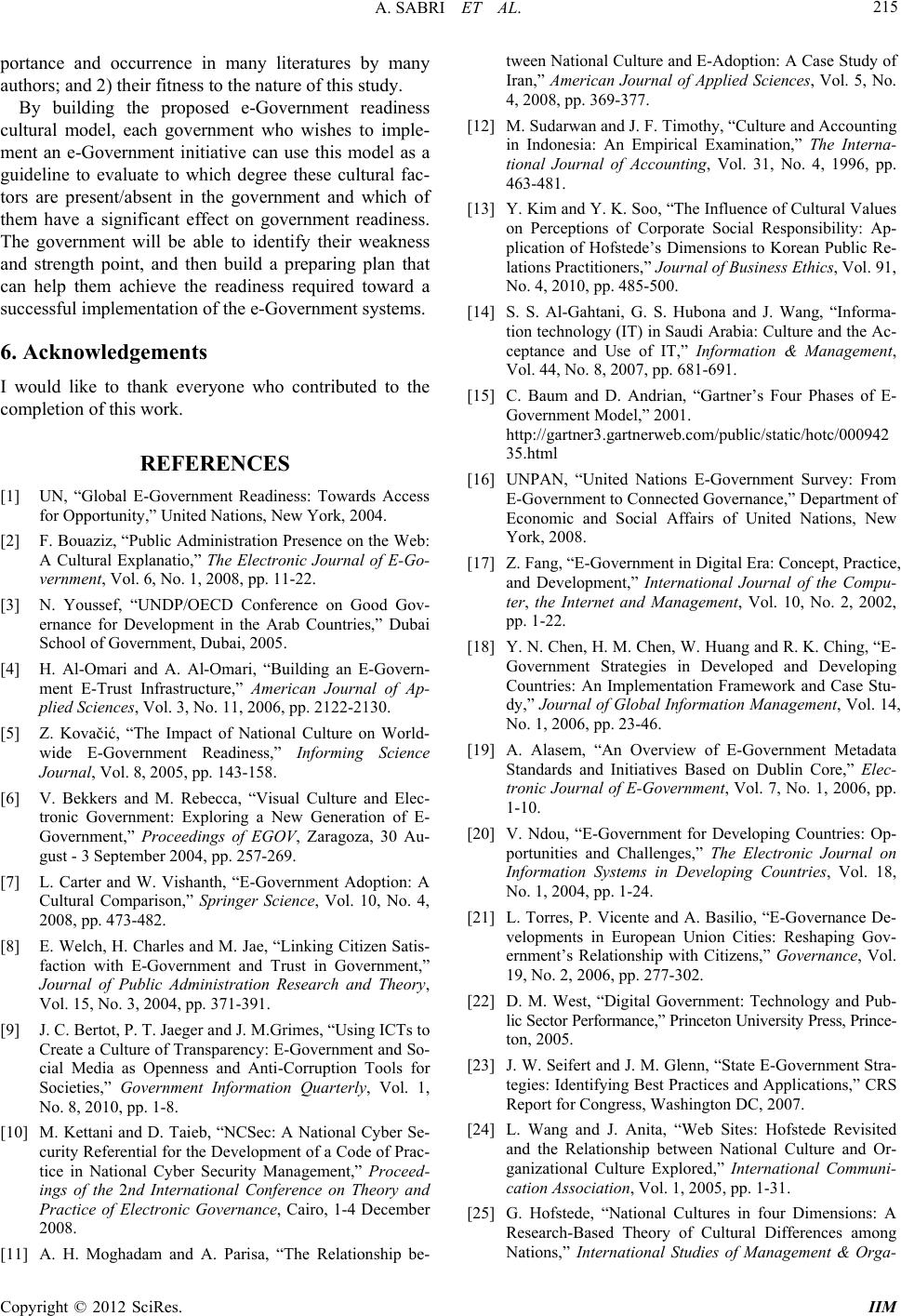
A. SABRI ET AL. 215
portance and occurrence in many literatures by many
authors; and 2) their fitness to the nature of this study.
By building the proposed e-Government readiness
cultural model, each government who wishes to imple-
ment an e-Government initiative can use this model as a
guideline to evaluate to which degree these cultural fac-
tors are present/absent in the government and which of
them have a significant effect on government readiness.
The government will be able to identify their weakness
and strength point, and then build a preparing plan that
can help them achieve the readiness required toward a
successful implementation of the e-Government systems.
6. Acknowledgements
I would like to thank everyone who contributed to the
completion of this work.
REFERENCES
[1] UN, “Global E-Government Readiness: Towards Access
for Opportunity,” United Nations, New York, 2004.
[2] F. Bouaziz, “Public Administration Presence on the Web:
A Cultural Explanatio,” The Electronic Journal of E-Go-
vernment, Vol. 6, No. 1, 2008, pp. 11-22.
[3] N. Youssef, “UNDP/OECD Conference on Good Gov-
ernance for Development in the Arab Countries,” Dubai
School of Government, Dubai, 2005.
[4] H. Al-Omari and A. Al-Omari, “Building an E-Govern-
ment E-Trust Infrastructure,” American Journal of Ap-
plied Sciences, Vol. 3, No. 11, 2006, pp. 2122-2130.
[5] Z. Kovačić, “The Impact of National Culture on World-
wide E-Government Readiness,” Informing Science
Journal, Vol. 8, 2005, pp. 143-158.
[6] V. Bekkers and M. Rebecca, “Visual Culture and Elec-
tronic Government: Exploring a New Generation of E-
Government,” Proceedings of EGOV, Zaragoza, 30 Au-
gust - 3 September 2004, pp. 257-269.
[7] L. Carter and W. Vishanth, “E-Government Adoption: A
Cultural Comparison,” Springer Science, Vol. 10, No. 4,
2008, pp. 473-482.
[8] E. Welch, H. Charles and M. Jae, “Linking Citizen Satis-
faction with E-Government and Trust in Government,”
Journal of Public Administration Research and Theory,
Vol. 15, No. 3, 2004, pp. 371-391.
[9] J. C. Bertot, P. T. Jaeger and J. M.Grimes, “Using ICTs to
Create a Culture of Transparency: E-Government and So-
cial Media as Openness and Anti-Corruption Tools for
Societies,” Government Information Quarterly, Vol. 1,
No. 8, 2010, pp. 1-8.
[10] M. Kettani and D. Taieb, “NCSec: A National Cyber Se-
curity Referential for the Development of a Code of Prac-
tice in National Cyber Security Management,” Proceed-
ings of the 2nd International Conference on Theory and
Practice of Electronic Governance, Cairo, 1-4 December
2008.
[11] A. H. Moghadam and A. Parisa, “The Relationship be-
tween National Culture and E-Adoption: A Case Study of
Iran,” American Journal of Applied Sciences, Vol. 5, No.
4, 2008, pp. 369-377.
[12] M. Sudarwan and J. F. Timothy, “Culture and Accounting
in Indonesia: An Empirical Examination,” The Interna-
tional Journal of Accounting, Vol. 31, No. 4, 1996, pp.
463-481.
[13] Y. Kim and Y. K. Soo, “The Influence of Cultural Values
on Perceptions of Corporate Social Responsibility: Ap-
plication of Hofstede’s Dimensions to Korean Public Re-
lations Practitioners,” Journal of Business Ethics, Vol. 91,
No. 4, 2010, pp. 485-500.
[14] S. S. Al-Gahtani, G. S. Hubona and J. Wang, “Informa-
tion technology (IT) in Saudi Arabia: Culture and the Ac-
ceptance and Use of IT,” Information & Management,
Vol. 44, No. 8, 2007, pp. 681-691.
[15] C. Baum and D. Andrian, “Gartner’s Four Phases of E-
Government Model,” 2001.
http://gartner3.gartnerweb.com/public/static/hotc/000942
35.html
[16] UNPAN, “United Nations E-Government Survey: From
E-Government to Connected Governance,” Department of
Economic and Social Affairs of United Nations, New
York, 2008.
[17] Z. Fang, “E-Government in Digital Era: Concept, Practice,
and Development,” International Journal of the Compu-
ter, the Internet and Management, Vol. 10, No. 2, 2002,
pp. 1-22.
[18] Y. N. Chen, H. M. Chen, W. Huang and R. K. Ching, “E-
Government Strategies in Developed and Developing
Countries: An Implementation Framework and Case Stu-
dy,” Journal of Global Information Management, Vol. 14,
No. 1, 2006, pp. 23-46.
[19] A. Alasem, “An Overview of E-Government Metadata
Standards and Initiatives Based on Dublin Core,” Elec-
tronic Journal of E-Government, Vol. 7, No. 1, 2006, pp.
1-10.
[20] V. Ndou, “E-Government for Developing Countries: Op-
portunities and Challenges,” The Electronic Journal on
Information Systems in Developing Countries, Vol. 18,
No. 1, 2004, pp. 1-24.
[21] L. Torres, P. Vicente and A. Basilio, “E-Governance De-
velopments in European Union Cities: Reshaping Gov-
ernment’s Relationship with Citizens,” Governance, Vol.
19, No. 2, 2006, pp. 277-302.
[22] D. M. West, “Digital Government: Technology and Pub-
lic Sector Performance,” Princeton University Press, Prince-
ton, 2005.
[23] J. W. Seifert and J. M. Glenn, “State E-Government Stra-
tegies: Identifying Best Practices and Applications,” CRS
Report for Congress, Washington DC, 2007.
[24] L. Wang and J. Anita, “Web Sites: Hofstede Revisited
and the Relationship between National Culture and Or-
ganizational Culture Explored,” International Communi-
cation Association, Vol. 1, 2005, pp. 1-31.
[25] G. Hofstede, “National Cultures in four Dimensions: A
Research-Based Theory of Cultural Differences among
Nations,” International Studies of Management & Orga-
Copyright © 2012 SciRes. IIM